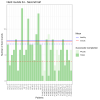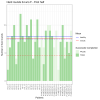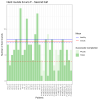I will play devils advocate for a moment:
Something that is quite striking and something I believe one still has to discuss, is that in the second half of the game both HV and ME/CFS chose to play hard more often than in the first half even though they percentually both complete it even less often than in the first half (I will additionally also cut the games in half after I have specified a fixed duration of games played to ensure that everyone gets to play the same number of games, this is typically what other studies have done).
The ratio of successful completion of hard/ choice of hard in the second half of the game for HV gets closer towards the ratio with which patients with ME/CFS start of the game with.
The main argument of Walitt is al in its simplified version is “pwME choose hard less often, this means they prefer to not use effort”. Now we are arguing “that is an incomplete assessment because pwME have lower chances of completing hard tasks and as such some in-game learning effects might lead to choosing hard less often rather than the intrinsic nature of pwME”.
The problem with this argument of ours, and something that Walitt et al can argue, is that comparing the second half of the game data to the first half of the game data shows that striking out more often doesn’t lead to choosing hard less often. I haven’t seen a convincing counterargument of our own against such a counterargument.
@Murph @bobbler @andrewkq
I think we've an underlying causal thing - the hard task being too difficult - which 'explains' behaviour in those with ME going into what looks like '3 groups'. But it isn't fatigue. That probably does layer in on top of it in additional ways. Fatiguability might be there as part of the handicap of people not being able to do more than 80 clicks on hard even at the start but that isn't the same as fatigue throughout the task?
If you look at the group who never had any chance of ever getting enough clicks to complete a hard (some are around 80 on the right hand side of the table) they've had to go into a game knowing this (from warm-up rounds) and come up with their own 'heuristic' that will necessarily be a pretty different decision-making task compared to HVs who have the game 'as intended'.
But we are no fools, and do remember what it was like not being disabled so I imagine many of us when given the instructions for that task can interpret what the experimenters are looking at/wanting to study and some of them might have thought the best they can do is 'decide as they would have' [if they weren't too disabled to actually complete the number of clicks] in order that they have that data. Seems a very reasonable assumption when you think you've signed up for that study so they can know more about how our minds and bodies work and they might have thought this is the best way
On the other hand you've a bunch of people (and who knows how far that extends into those on the left of the ME-CFS table) who completing the number of clicks for the hard tasks is 'near-miss' just a step too far, or 'maybe attainable if I were to pace myself and then really throw myself at it after a rest'. Well those people have a different choice in heuristics - do they do what the group above I've described have done, or do they play the game the best they can and try and maximise their abilities - adding another big element into the game and choice for them. AN element which overwhelms the subtleties of the other elements of the choice task.
Just because the two cancel themselves out. And just because it isn't 'fatigue' to me isn't an issue - because I think that the first problem is the lack of calibration to physical abilities. Not to fatigue. They could study fatigue if they like, but they'd need to have made sure that eg the hard isn't more than 85% of the maximum of what people were capable of doing on clicks (as another study did, and which I suspect is the situation on average for HVs) -
then you might be able to actually study fatigue, like you've begun to spot with the HVs.
Or any other aspect. So it makes the data un-analysable? But one good thing comes from it, which is how important focusing on getting a format that is appropriate for the abilities of this cohort is/would be if you want to study anything in this cohort in future.
It could be a different 'game' or tool with a different issue: like a computer game that involved using a controller with button clicking and realising that potentially 50% of the group couldn't use one of the buttons (and it mightn't be a health reason it could have been a sticky controller), or a game that involved something more physical and a slippy floor meaning those who weren't wearing the right trainers were having to change their decisions based on not making any sharp turns. Neither would preclude there also being a fatigue issue on top of that.
And some might decide it was best in the circumstances (trying to get inside the mind of what the investigators would be looking at) to pretend the x button doesn't stick and play as if it worked normally, whereas (given it was a psych experiment after all) others might have 'worked around it'.
Treadway and OHmann have both tried to touch on the fatiguing issue and possible ways in HVs to avoid that influence (and of course that will be physical - whether you can do the buttons, but could also be cognitive - whether you want to just make your choice-making simpler by going 'only high probability')
WHich is another 'signal' layered on top of the choice stuff and what the test might be looking at too. But at least you'd expect to see it over time
if you hadn't put people in rolling PEM before-hand of course - and if you had then the components of the task would also matter - because ME isn't as straight forward as people assume (we get wired-tired and sometimes it affects our pace sometimes it affects our accuracy whilst our pace stays high).
But my point is that these are still pure hypotheses because the floor/ceiling effect means that completing hard was inaccessible or 'above taxing' for most of one group. WHIch drowns out all of that data.
It really is like being thrown into a dance class with some sort of handicap and working out whether you do your best to get the steps right that you can and 'look gawky and don't finish' or whether you do your best to not stand out and look like you aren't struggling by gesturing towards what people are doing rather than trying the actual moves (and coming a cropper). You can't really assess those people on anything other than that 'situationally' - whatever the dance routine was intended to 'assess'?






